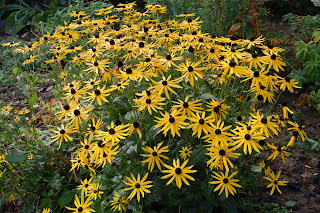The garden now is daisy-heaven. There is an incredible array of this versatile family for late season flower. Most of them North American - the Asteraceae must have gone on an evolutionary binge during some or all of the interglacials of the last million years. Maybe it was the way plantlife was pushed down by the ice every few 100,000 years and had to reconquer territory that drove the evolution of prairie flora. Heliopsis helianthoides (above) is a classic daisy. Its common as a cottage garden plant in British country villages, one of those plants that gets divided up and given to people or sold in yogurt pots or plastic bags at the church fete, losing its identity in the process. I actually grew this from seed from Prairie Moon in Wisconsin, but I prefer the church fete version, which has darker foliage.
Aster 'Little Carlow' is the gold standard aster - free flowering for a long time, disease free and slowly spreading. This lot are ok, but the row in the pic below have o-deed on this years rain and the general fertility of the soil and flopped horribly, which is most uncharacteristic of them. I got the glass ornament from a factory shop near Passau, Germany.
There are zillions of named cultivars of Aster novae-angliae. In fact you could make your own selection by stopping by the side of many an interstate in the eastern US and digging up a few clumps - the level of natural variation is quite amazing. But of course there aren't any varieties called 'New Jersey Turnpike no.2' because it was enterprising Brit and German nurserymen in the early 20th century who realized their value as garden plants. They stand upright (usually) and flower brilliantly. Shame about the bare legs mind.
I was introduced to Aster pyrenaeus 'Lutetia' by Chris Marchant of Orchard Dene nurseries, where all cool garden designers in southern England buy their perennials. It is one of Europe's very few really garden-worthy asters, but a rare plant in nature apparently.
A. turbinellus is a new one for me, a bit disappointed so far, insubstantial and wishy-washy, but maybe i should be patient and see what it does next year.
This is a real favourite. Yes, I know that things you collect yourself are going to be regarded with as much objectivity as looking at one's own children. Aster puniceus though is a damned good plant - and it used to be in cultivation in Europe but died out sometime in the 20th century - heaven knows why as it seeds like crazy (but does not spread vegetatively). It flowers from late August on for up to two months and makes a nice misty blue backdrop for lots of other colours. I got the seed off a few plants by a roadside swamp in the Catskills sometime in the early 2000s.
Kalimeris mongolica is a member of an Asian genus close to Aster. Pretty, free-flowering but grows stems at an awkward angle. Some idiot, in a desperate attempt at making it memorable for the latin-name-phobic has named it the 'Genghis Khan' aster. Which makes you think it spreads like mad and lays waste everything in sight, which it does not.
Not sure about Aster praealtus yet. Very robust, does not appear to spread (yet!) and very tall. Palest mauve flowers. Might be a good back of border or pretend-prairie plant.
There was a fashion for creating dwarf asters in the early 20the century, much of it driven by the need to have flowers on war graves. This is 'Purple Dome', originally German apparently. But, as you can see, they occasionally throw out 'normal' shoots which grow so much taller.
Aster umbellatus is anything but dwarf, at nearly 2m. This lot have flopped badly but after our horrendously wet summer that is not entirely surprising. Masses of white flowers and an erratically spreading habit.
Helianthus 'Lemon Queen' just has to be one of the best perennials of the last 20 years. Does not spread aggressively but very robust.
Its big sister is H. 'Sheila's Sunshine' which is the very tall (3m +) at the back here, not quite in flower yet, but primrose greeny-yellow when it does. Fantastically strong, but I suspect too tall for most people- who lets face it do not like being shorter than their perennials. Eupatorium 'Orchard Dene' in front - around the onepointsomething metre mark - again useful for those who can't cope with the 3m joe pye weeds.
Rudbeckia laciniata has turned out to be a ruthless thug, overwhelming other prairie perennials in one of my plots. So its going to be banished to a new project I'm developing elsewhere.
Rudbeckia triloba is a short-lived species which smothers itself in flowers. Looks great with blue asters, like A. puniceus. So exuberant.This seed is from Prairie Moon too, with much more star-shaped flowers than the usual rather rounded form we see.
Rudbeckia fulgida 'Goldsturm' is simply the best yellow, and a useful not overwhelming height.
Finally, forget not that goldenrods are daisies too. This is the view from my office, with Solidago rugosa as a component in some research plots looking at competition. Its much the best goldenrod, being robust and reliable but spreading only slowly, a graceful and elegant plant. There are many others though, which I am working my way through, and so many of them are quite unlike the thuggish S. canadensis types that have given them all a bad name.
And even more finally, Leucanthemella serotina, a Hungarian species which flowers pretty much last of all.


















0 Response to "It's autumn so it's daisy time"
Post a Comment